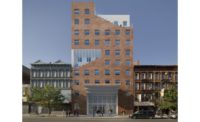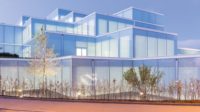The sight of a bushy, white, curvilinear 17-story tower in the city of Montpellier, France, could stop you in your tracks. And this is before you notice that the balconies of this mostly residential building extend out like branches of a thickly foliated tree, almost defying gravity. Aptly called L’Arbre Blanc (White Tree), the recent addition to the city of 278,000, close to the Mediterranean, makes a dramatic gesture to the region’s sunny climate. Here 113 luxury apartments, contained in the “trunk,” open onto balconies that cantilever as much as 25 feet.
The organic design was conceived by a team led by Tokyo architect Sou Fujimoto, working with three Paris-based architects: Manal Rachdi of OXO Architects; Nicolas Laisné, and Laisné’s former partner Dimitri Roussel. The project is the second result of a series of competitions started by Montpellier in 2013, called the Folies Richter, to bring more experimental architecture to the city. (The first winner, a nine-story apartment block, La Folie Divine, was designed by London-based architect Farshid Moussavi, and opened in 2017.)
Montpellier officials hope to commission a dozen such more “folies” in the future that will join a variegated assortment of buildings previously designed by such architects as Ateliers Jean Nouvel, Zaha Hadid Architects, Studio Fuksas, and Ricardo Bofill (Taller de Arquitectura).
In this case, Laisné and Rachdi, who had both worked for Jean Nouvel, wanted to enter the competition but in partnership with a more experienced architect: the RFP encouraged younger generations of architects to collaborate with somewhat older ones. Even though Fujimoto, age 48, hadn’t practiced in France, his ethereal and idiosyncratic residential work, such as the N House, House NA, and House K had brought him international stature.
Fujimoto was game. The designers all convened for a five-day charrette in Tokyo to generate the Montpellier scheme. When they won the competition in 2014, Fujimoto set up shop in Paris, and brought in Marie de France as project architect. (In 2016, the Paris office won another competition—with Laisné and Roussel—for the arresting Vertical Village proposal in Rosny-sous-Bois, part of the Grand Paris urban plan.)
Since the 25,000-square-foot site for L’Arbre Blanc along the Lez River offered panoramic views of the city, the brief called for a rooftop bar and restaurant for the public. In addition, an art gallery occupies the base, with coworking office space on the floor above.
From several angles, the tower appears to be cylindrical, although the plan is actually kidney-shaped, which allowed longer, gentler curvilinear expanses for the generously proportioned apartments, many of which have two balconies. Even so, the reinforced- concrete column-and-slab structure and the enclosing walls rely on faceted planes, instead of curves, to bend around corners.
The facade is clad in white metal. The balconies are formed of built-up welded sections and bolted to vertical steel H-beams, which in turn are fixed to the concrete floor slabs. While the balconies appear to be cantilevered, they are connected to the tower by tie rods. Basically steel trays, their loads have been calculated according to their orientation and length, and the assemblages are covered with fireproofing and wood decking. Steel pergolas above the terraces act as brises-soleil.
These extrusions seem to float; the exterior stairs that connect the terraces of the few duplex apartments might pose exciting moments for those who are susceptible to vertigo. But on a beautiful evening at sunset, with plenty of Languedoc wine, you can relax and forget any fears of going out on a limb.











Post a comment to this article
Report Abusive Comment